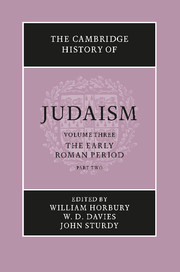Book contents
- Frontmatter
- 1 The archaeology of Palestine 63 bce–ce 70
- 2 The Herodian Temple
- 3 Recent archaeology in Palestine: achievements and future goals
- 4 The contribution of Jewish inscriptions to the study of Judaism
- 5 The social, economic and political history of Palestine 63 bce–ce 70
- 6 The Diaspora in the Roman period before ce 70
- 7 The Gentiles in Judaism 125 bce–ce 66
- 8 Gentiles as seen by Jews after ce 70
- 9 The synagogue
- 10 The Temple and the synagogue
- 11 The early liturgy of the synagogue
- 12 Women in the synagogue
- 13 The Pharisees
- 14 The Sadducees – their history and doctrines
- 15 The Essenes
- 16 The baptist sects
- 17 The troublemakers
- 18 The Samaritans and their sects
- 19 Galilean Judaism and Judaean Judaism
- 20 Jesus: from the Jewish point of view
- 21 Paul: from the Jewish point of view
- 22 Jewish Christianity
- 23 Apocalyptic: the disclosure of heavenly knowledge
- 24 The Qumran sectarian writings
- 25 The Dead Sea Scrolls and pre-Tannaitic Judaism
- 26 Prayer in the Qumran Texts
- 27 Philo of Alexandria
- 28 Josephus (ce 37–c. 100)
- 29 The rabbi in second-century Jewish society
- 30 The Hellenistic–Roman Diaspora ce 70–ce 235: the archaeological evidence
- 31 The legacy of Egypt in Judaism
- 32 Jewish elements in gnosticism and magic c.ce 70–c.ce 270
- Bibliographies
- Index
- References
8 - Gentiles as seen by Jews after ce 70
Published online by Cambridge University Press: 28 March 2008
- Frontmatter
- 1 The archaeology of Palestine 63 bce–ce 70
- 2 The Herodian Temple
- 3 Recent archaeology in Palestine: achievements and future goals
- 4 The contribution of Jewish inscriptions to the study of Judaism
- 5 The social, economic and political history of Palestine 63 bce–ce 70
- 6 The Diaspora in the Roman period before ce 70
- 7 The Gentiles in Judaism 125 bce–ce 66
- 8 Gentiles as seen by Jews after ce 70
- 9 The synagogue
- 10 The Temple and the synagogue
- 11 The early liturgy of the synagogue
- 12 Women in the synagogue
- 13 The Pharisees
- 14 The Sadducees – their history and doctrines
- 15 The Essenes
- 16 The baptist sects
- 17 The troublemakers
- 18 The Samaritans and their sects
- 19 Galilean Judaism and Judaean Judaism
- 20 Jesus: from the Jewish point of view
- 21 Paul: from the Jewish point of view
- 22 Jewish Christianity
- 23 Apocalyptic: the disclosure of heavenly knowledge
- 24 The Qumran sectarian writings
- 25 The Dead Sea Scrolls and pre-Tannaitic Judaism
- 26 Prayer in the Qumran Texts
- 27 Philo of Alexandria
- 28 Josephus (ce 37–c. 100)
- 29 The rabbi in second-century Jewish society
- 30 The Hellenistic–Roman Diaspora ce 70–ce 235: the archaeological evidence
- 31 The legacy of Egypt in Judaism
- 32 Jewish elements in gnosticism and magic c.ce 70–c.ce 270
- Bibliographies
- Index
- References
Summary
Let us begin with a frank avowal not only of the incompleteness of our evidence from the Jewish side, but also of its one-sidedness. Tannaitic sources reflect the pietistic leadership of the scribes and sages, successors of the pharisees. It should not be assumed that the rabbinic views were enthusiastically endorsed by the entire community; indeed, as regards their minutiae, at the periphery of the community perhaps no more than lip service was given. Alternative religious groupings (e.g. Qumran, the Jewish Christians), occasionally disapprobated in the Mishnah, were either disappearing fast, or were in process of disassociating themselves from (or being extruded by) the main Jewish community. The ‘Am ha-’ares – scholastically unreachable common folk – were regarded by the rabbis with a barely tolerant contempt, reminiscent of fifth-century Greek attitudes to ‘the masses’ as contrasted to ‘gentlefolk’. One need not doubt that emotional ties and an inarticulate sense of ethnic identity linked them with more obviously practising Jewish circles, but their ethnicity was without self-consciousness, and they probably described themselves in Palestine – as in the Diaspora all Jews were described – as ‘Judaeans’ (yehudim, Aramaic yehuda'e): a term not thus used in rabbinic literature, where an individual Jew is called (an) Israel (ite). The great suffering of Jews in Palestine, Egypt and Cyrenaica, in the wars and revolts against Rome will have made it difficult or impossible for Jews to ignore the reality of Jewish–Gentile distinctions, even when, as individuals, they may have wished to play them down or attempt to overcome them by assimilative integration in the gentile world.
- Type
- Chapter
- Information
- The Cambridge History of Judaism , pp. 250 - 266Publisher: Cambridge University PressPrint publication year: 1999
References
- 1
- Cited by



